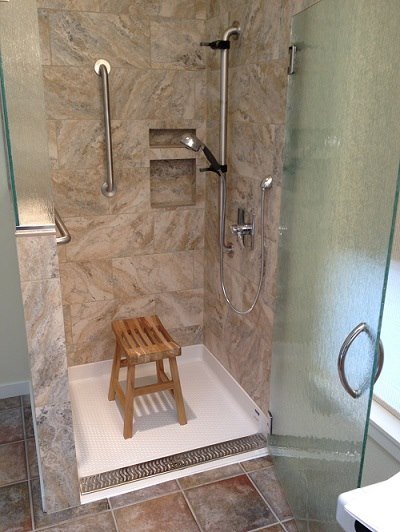Homeowners remodel their bathrooms for a variety of reasons, including to modernize fixtures, increase storage, update plumbing, and of course to breathe new life and style into the space. Remodeling to improve accessibility has become increasingly more common as families wish to make their homes safer for aging relatives, safeguarding against injuries and making the bathroom and its doorways wheelchair-accessible. When you remodel to increase bathroom accessibility, you don’t need to sacrifice your style and aesthetics; with the right products, design, and layout, an accessible bathroom will be stylish and safe.
Widening Doorways
When improving bathroom accessibility for disabilities, one of the first tasks is to widen doors to a minumum 32 inches for easy wheelchair access. If the door is located in a hallway or near a corner that requires turning space, doors are widened to 36 inches. The space inside the bathroom should be large enough to accommodate the turning radius of the wheelchair, and to allow for the individual to park his or her chair when using the shower, tub, or toilet.
Accessible Toilets
Bathrooms with disability access demand toilets that are higher than those typically installed in homes; designers often use an ADA toilet and/or a raised seat which allows individuals in wheelchairs and those with mobility issues to comfortably and safely use the lavatory. Grab bars are typically installed next to the toilet for added safety, and come in a variety of styles and finishes to match most bathroom décor. Bidet seats, while offering a touch of luxury, also make a great accessible addition to the bathroom for those with limited arm or hand mobility. Instant hot water, heated dryer and preset cleaning patterns allow anyone to be clean, hands free and without help.
Accessible Sinks and Vanities
Sinks are another concern, as traditional vanities can impede wheelchair access or are often too low for seniors to use comfortably. We recommend pedestal sinks for their added height for homeowners who are able to walk to the vanity itself; lower vanities that are open directly beneath the sink and faucet (much like a desk) are ideal for homeowners who need wheelchair access. Faucets should be easy to use without straining the hand and arm, and sensor or touch designs are often perfect alternatives to the traditional spout and handle configuration.
Anti-Slip Flooring
Flooring is an important concern for senior-friendly bathrooms as slippery floors or those that allow water to pool can pose serious threats. Slip-resistant flooring is a wonderful solution for all bathrooms, but is especially important when homeowners have limited mobility or use a wheelchair. Anti-slip flooring is available in many materials, styles, and colors to coordinate with the overall design of the bathroom; and helps to reduce slips and falls near the tub and sink.
Safety Features for the Bathtub and Shower
Standard showers and tubs are often cited as the source of injuries in the home, so it’s crucial to implement new designs that will keep homeowners safe. Slip-resistant tubs provide the traction necessary to keep individuals safe and provide peace of mind.
Grab bars for showers are another excellent modification, and like those used near toilets and sinks, are available in stylish designs to complement the bathroom and enhance the overall beauty of the space. Curb-free shower bases make it simple for wheelchair users to wheel straight into the shower and transfer to a sitting bench for a safe and effortless shower experience. Hand-showers on adjustable slide bars are a great addition to any bathroom, not just for accessibility reasons but for family members of all shapes and sizes (including the little ones!)
Shower safety bars provide grip and stability for the elderly and individuals in wheelchairs while bathing, and can further benefit families with young children who also use the space. Walk-in tubs are a fantastic option for comfortable and safe baths, as they have a low base to step over, and the door has a pressure seal that prevents leaks.
A Remodel to Stand the Test of Time
Designers can help homeowners remodel their bathrooms to address mobility and safety concerns while creating a space that is stylish and suits the home itself. Whether you simply need to install a few grab bars for bathroom safety and replace a toilet, or wish to completely remodel your space for maximum accessibility, hiring professionals can help you create your dream space.


The bathroom is one of the most important rooms in the house, and it’s especially important for people with mobility issues. A well-designed accessible bathroom can make it easier for people to get in and out of the shower or bathtub, use the toilet, and wash their hands.
Thank You For Sharing Helpful Post.